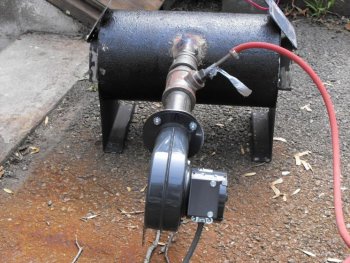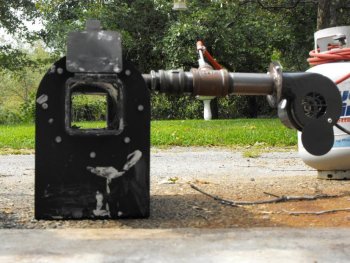I can speak from my experience, and I was taught by Ed Caffrey, who I will tell EVERBODY just how wonderful a person he is, because he basically held my hand through me building my first FORGE, which I might add was the most terrifying experience in my life...well, that and parenthood! But as far as building an apparatus that as Ed explained it, " contains a controlled explosion", that really settled my nerves! No, not REALLY! The problem I was having was I thought I wanted to build the Venturi type burner, and when Ed starts explaining to me that a blown gas forge burner would not only be easier, it's as controllable if not MORE CONTROLLABLE than a Venturi and cheaper to build, if you go with something like a basic squirrel cage blower like they have for sale at Surplus Center.com, (I think that's the name of it, if you really want it, I will look it up for you) they have several different sizes of that type of blower,the way that Ed had explained it to me, is that you do not know how long one will last, on a positive back pressure design like this type. It may last a week, a day, a month, possibly even a year, but inevitably they will go out, because of the positive back pressure. I dont really enjoy building things all that much, I enjoy learning new skills, I enjoy the rewards of a new well built tool, so I guess my logic was to build it the best I could and to take every ounce of Ed's advice, and he did advise me to buy the blower from Blacksmith depot(.com) , I think their also called Kahn and son, or something like that, now this blower is a bit more expensive than the ones in Surplus Center, I paid $120 for mine +shipping! And he did tell me to buy ONLY what I could afford. That was 6 almost 7 years ago, I don't know what they cost now, but I would bet they are still built with the same quality. Now a few things I've learned since I built my first forge, you don't need to make the pipe extra long, you probably should start off with a 2" pipe, and reduce it but that is simply to recieve the blower. I made the plate to attach my blower to my pipe, but now they have them already made, they weren't real cheap, but I want to say they seemed affordable for what you got which was a way to basically be able to screw all of the blower assembly to the pipe you buy locally, and with a "T" coupling add the correct size reducer to it, so it will recieve the gas line, oh and make sure you use the "P" tape for every fitting, I'm fanatical about that, mainly because I've built 2 forges so far, and basically 2 burners, and have not had the first leak of any kind. The P stands for propane, very similar to Teflon tape for water but P tape is much thicker and usually yellow or pink in color. Now as to if it will forge weld, that is a tough question for me to answer, I would say, "it should", but I won't guarantee it, there are several factors to getting everything just right, someone mentioned positioning the burner into the forge on a tangent, slightly angled forward, what this does is creates a vortex of fire and mainly heat, like nothing you've ever experienced! It totally blew me away when I lit mine for the first time! The first forge I built was my second forge, my first forge I bought off eBay from some crack pot that didn't know a blacksmith from a bladesmith, swore to me that a downward pointing burner would work perfectly for knife making! Even after I objected, told him that from what I had read was that knife makers needed indirect heat, and that it was important to have a forge that didn't have any cold spots, he said that if my steel was under the flame I wouldn't have to worry about a cold spot! So I have to say that I lived and I learned! I was new to the forging, lacking a lot of confidence to build things myself not mention things that had the potential to be a BOMB! So, lesson learned and now I have no problem at all building a forge or anything else for that matter. Its almost like an adventure, learning all of these new things, and then building things that can actually do the thing it was intended to do and do it well! Yeah, In the past I was the guy that who put anything together, there was always that bag of left over parts, I didn't have the experience that a lot of others had before they got started in this obsession we call knifemaking! Dad wasn't the "do it yourselfer" type, he wouldn't even change his own oil, back in the day when everyone I knew, their Dads changed their own oil, not mine, he just wasn't into it, thank God he liked to fish! Anyway, with a little bit of pipe, a blower (you decide on which one), and most important to this entire deal (other than Propane), a NEEDLE VALVE, make sure you get the kind that will screw into the gas line, I bought several, only to take them back because none of them worked the way I wanted them to or wouldn't fit at all, so I ordered mine from online, Hightemp tools.com, Wayne knows his stuff, the guy builds these big furnaces for steel mills or something like that, well he might design them, maybe not build. Anyway he has just about everything you'll need and BTW, THE BEST PRICE FOR ITC-100 I have ever seen, 1 pint is $69.95!!!Other places it was like 90 something bucks! Also he has the correct regulator for forges, as well as .psi gauges, Inswool, Satanite, Mizzou, and a dozen other things you will want to buy! He is a great guy and will answer ALL OF YOUR QUESTIONS, he's usually pretty fast, but I think he may be working another job now, so give him a chance, he's in Alabama, so you know he's good people! A pretty good distance from me, but I still order my stuff from him. Most of the time, Wayne Coe is good too, and he's on KD all the time. So I'm sure he'll chime in as well.
I sure hope all this helps, remember once you get started it'll have you buying $100 dollar hammers before you know it! Its just another sickness to go with knife making! Hand in hand I'd say! But seriously speaking, there is no feeling like making steel yield to YOUR WILL!
If you need anything else, I'll help any way I can just give me a holler, and one more thing, make sure you understand the burner on a Tangent, that is of upmost importance!
Rex
BTW, Just kidding about the $100 dollar hammer, they're like $80!



